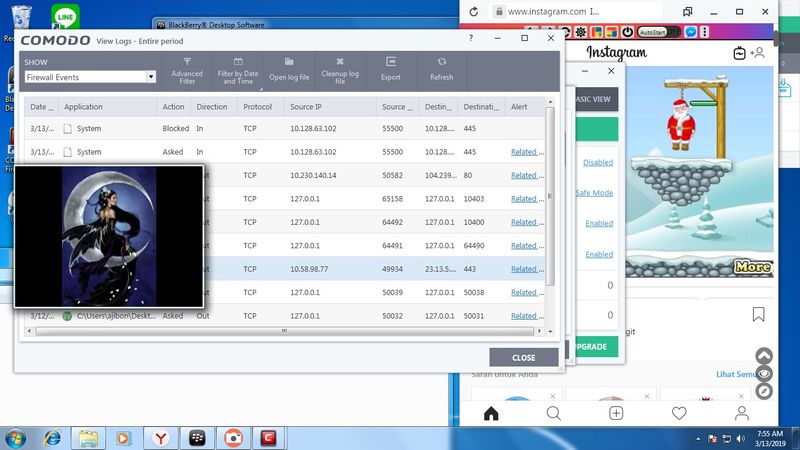GARUDAMON GUIDE ... PORT 445
 Port 445 Details
Port 445 Details
known port assignments and vulnerabilities
threat/application/port search:
Port(s) | Protocol | Service | Details | Source | 445 | tcp | microsoft-ds | TCP port 445 is used for direct TCP/IP MS Networking access without the need for a NetBIOS layer. This service is only implemented in the more recent verions of Windows (e.g. Windows 2K / XP). The SMB (Server Message Block) protocol is used among other things for file sharing in Windows NT/2K/XP. In Windows NT it ran on top of NetBT (NetBIOS over TCP/IP, ports 137, 139 and 138/udp). In Windows 2K/XP, Microsoft added the possibility to run SMB directly over TCP/IP, without the extra layer of NetBT. For this they use TCP port 445.
Port 445 should be blocked at the firewall level. It can also be disabled by deleting the HKLM\System\CurrentControlSet\Services \NetBT\Parameters\TransportBindName (value only) in the Windows Registry.
MS Security Bulletin [MS03-026] outlines a critical RPC vulnerability that can be exploited via ports 135, 139, 445, 593 (or any other specifically configured RPC port). You should filter the above mentioned ports at the firewall level and not allow RPC over an unsecure network, such as the Internet.
See also: Microsoft Security Bulletin [MS03-049] and Microsoft Security Bulletin [MS03-043]
W32.Zotob.C@mm (08.16.2005) - a mass-mailing worm that opens a backdoor and exploits the MS Plug and Play Buffer Overflow vulnerability (MS Security Bulletin [MS05-039]) on port 445/tcp. It connects to IRC servers and listens for remote commands on port 8080/tcp. It also opens an FTP server on port 33333/tcp.
W32.Zotob.D (08.16.2005) - a worm that opens a backdoor and exploits the MS Plug and Play Buffer Overflow vulnerability (MS Security Bulletin [MS05-039]) on port 445/tcp. Conects to IRC servers to listen for remote commands on port 6667/tcp. Also opens an FTP server on port 1117/tcp.
W32.Zotob.E (08.16.2005) - a worm that opens a backdoor and exploits the MS Plug and Play Buffer Overflow vulnerability (MS Security Bulletin [MS05-039]) on port 445/tcp. It runs and spreads using all current Windows versions, but only infects Windows 2000.
The worm connects to IRC servers and listens for remote commands on port 8080/tcp. It opens port 69/udp to initiate TFTP transfers. It also opens a backdoor on remote compromised computers on port 8594/tcp. Port 445/tcp also used by the W32.Zotob.Hvariant of the worm.
W32.Conficker.worm - a worm with multiple variants. It exploits a buffer overflow vulnerability in the Server Service on Windows computers. McAfee has named the most recently discovered variant of this worm as W32/Conficker.worm.gen.d. The original W32.Conficker.worm attacks port 445, the port that Microsoft Directory Service uses, and exploits Microsoft Windows vulnerability [MS08-067].
Buffer overflow in a certain driver in Cisco Security Agent 4.5.1 before 4.5.1.672, 5.0 before 5.0.0.225, 5.1 before 5.1.0.106, and 5.2 before 5.2.0.238 on Windows allows remote attackers to execute arbitrary code via a crafted SMB packet in a TCP session on port (1) 139 or (2) 445.
LANMAN service on Microsoft Windows 2000 allows remote attackers to cause a denial of service (CPU/memory exhaustion) via a stream of malformed data to microsoft-ds port 445.
| SG | 445 | tcp |
| Microsoft-DS Active Directory, Windows shares (official) | Wikipedia | 445 | udp |
| Microsoft-DS SMB file sharing (official) | Wikipedia | 445 | tcp | trojan | Nimda | Trojans | 445 | tcp,udp | microsoft-ds | Win2k+ Server Message Block | SANS | 445 | tcp | microsoft-ds | SMB directly over IP | Nmap | 445 | udp | microsoft-ds | microsoft-ds | Nmap | 445 | tcp | threat | Netdepix | Bekkoame | 445 | tcp | threat | Otinet | Bekkoame | 445 | tcp | threat | Rtkit | Bekkoame | 445 | tcp | threat | Secefa | Bekkoame | 445 | tcp | threat | W32.Aizu | Bekkoame | 445 | tcp | threat | W32.Bobax | Bekkoame | 445 | tcp | threat | W32.Bolgi.Worm | Bekkoame | 445 | tcp | threat | W32.Cissi | Bekkoame | 445 | tcp | threat | W32.Cycle | Bekkoame | 445 | tcp | threat | W32.Explet | Bekkoame | 445 | tcp | threat | W32.HLLW.Deborms | Bekkoame | 445 | tcp | threat | W32.HLLW.Deloder | Bekkoame | 445 | tcp | threat | W32.HLLW.Gaobot | Bekkoame | 445 | tcp | threat | W32.HLLW.Lioten | Bekkoame | 445 | tcp | threat | W32.HLLW.Moega | Bekkoame | 445 | tcp | threat | W32.HLLW.Nebiwo | Bekkoame | 445 | tcp | threat | W32.HLLW.Polybot | Bekkoame | 445 | tcp | threat | W32.Ifbo | Bekkoame | 445 | tcp | threat | W32.Janx | Bekkoame | 445 | tcp | threat | W32.Kibuv.Worm | Bekkoame | 445 | tcp | threat | W32.Kiman | Bekkoame | 445 | tcp | threat | W32.Korgo | Bekkoame | 445 | tcp | threat | W32.Mytob | Bekkoame | 445 | tcp | threat | W32.Reatle | Bekkoame | 445 | tcp | threat | W32.Sasser | Bekkoame | 445 | tcp | threat | W32.Scane | Bekkoame | 445 | tcp | threat | W32.Slackor | Bekkoame | 445 | tcp | threat | W32.Spybot | Bekkoame | 445 | tcp | threat | W32.Wallz | Bekkoame | 445 | tcp | threat | W32.Welchia | Bekkoame | 445 | tcp | threat | W32.Zotob | Bekkoame | 445 | tcp,udp | microsoft-ds | Microsoft-DS | IANA |
|
39 records found
External Resources
Notes:
Well Known Ports: 0 through 1023.
Registered Ports: 1024 through 49151.
Dynamic/Private : 49152 through 65535.
TCP ports use the Transmission Control Protocol. TCP is the most commonly used protocol on the Internet and any TCP/IP network. Whereas the IP protocol deals only with packets, TCP enables two hosts to establish a connection and exchange streams of data. TCP guarantees delivery of data and that packets will be delivered in the same order in which they were sent. Guaranteed communication/delivery is the key difference between TCP and UDP.
UDP ports use the Datagram Protocol, a communications protocol for the Internet network, transport, and session layers. Like TCP (Transmission Control Protocol), UDP is used with IP (the Internet Protocol) and makes possible the transmission of datagrams from one computer to applications on another computer, but unlike TCP, UDP is connectionless and does not guarantee reliable communication; it's up to the application that received the message to process any errors and verify correct delivery. UDP is often used with time-sensitive applications, such as audio/video streaming, where dropping some packets is preferable to waiting for delayed data.
When troubleshooting unknown open ports, it is useful to find exactly what services/processes are listening to them. This can be accomplished in both Windows command prompt and Linux variants using the "netstat -aon" command. We also recommend runnig multiple anti-virus/anti-malware scans to rule out the possibility of active malicious software. For more detailed and personalized help please use our forums.
 Port 445 Details
Port 445 Details


